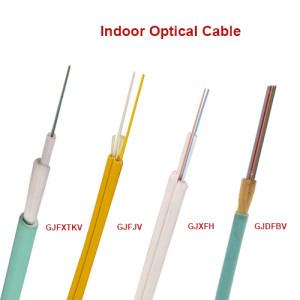- Related articles
- All Cisco SFP-GE-T's information (List price, Specs, Datasheet PDF, Compatibility matrix)
- All Cisco DWDM-XENPAK-31.12's information (List price, Specs, Datasheet PDF, Compatibility
- The Difference Between X2 and XFP
- Installation of Fiber Optic Cable
- All Cisco SFP-10G-BXU-I's information (List price, Specs, Datasheet PDF, Compatibility mat
- The difference between GBIC and SFP
- All Cisco GLC-LX-SM-RGD's information (List price, Specs, Datasheet PDF, Compatibility mat
- Optical Transceivers for Cisco WS-C2960S-F48TS-L Switch
- What is 10GBASE-T transceiver?
- Difference between GLC-T and SFP-GE-T

Definition of Indoor Fiber Optic Cable
Indoor Fiber Optic Cable is the type of fiber optic cable that is widely used for the in-house application. This type of fiber cable has no sufficient features for protection and therefore, the cable can easily be damaged if install outside the building. In other words, it has a soft sheath which can easily be destroyed. Nevertheless, Indoor Fiber Optic Cable has features that enable it to fit very well in its purpose.

Application of Indoor Fiber Optic Cable
Indoor fiber optic cable has two primary applications. A majority of the indoor cable is used in building wiring applications. Installed in walls, between floors, in plenum air handling ducts and under data center floors, HCA fiber cable used in building wiring applications is built to withstand the tensile stresses present during installation by the contractor, and, once installed, will provide a safe shroud for many years of trouble-free glass use.
The indoor cable that is used specifically for patching applications is typically more robust in design and capable of superior flex and crush requirements. High volume contractorization processes require cable diameter consistency, long continuous lengths, and outstanding appearance aesthetics. HCA patch cable designs provide the assembler with interconnecting solutions backed by years of proven performance.
A majority of the indoor cable is used in building wiring applications. Installed in walls, between floors, in plenum air handling ducts and under data center floors, HCA fiber cable used in building wiring applications is built to withstand the tensile stresses present during installation by the contractor or assembler, and, once installed, will provide a safe shroud for many years of trouble-free glass use.
Indoor/outdoor Fiber Optima cable is rugged and flexible, for an easy transition from outdoors to indoors. It eliminates the need for splicing or transitioning at the building entrance. This riser-rated cable is available in stranded loose tube and central loose-tube designs. Both types of cable have a CommFlex jacket for improved handling and placement, easy-to-strip fibers, and vibrant coloring.
Identification of Indoor Fiber Optic Cable
• Hitachi Cable America utilizes Corning Optical Fiber as its standard fiber for OM2, OM3, OM4, OM5 and OS2 constructions.
• Each Fiber is Color Coded for Easy Identification
• Compact Distribution Design
• Ideal Intra-Building, Multi-Floor Cable Solution
• Lightweight, Flexible Aramid Yarns Enhance Strength
Uses of Indoor Fiber Optic Cable
1. Plenum
The plenum is defined as any enclosed area that facilitates environmental air handling. Cable jackets used in plenum spaces are rated for both flame and smoke generation.
2. Riser
Riser cable jackets are rated for flame generation and are held to a lower standard than plenum cables.
3. Low-Smoke Zero Halogen (LSZH™)
LSZH cables eliminate toxic gasses produced when water interacts with a burning cable jacket.
Conclusion
The activities in the companies have been boosted largely through used of Indoor Fiber Optic Cables in the operations. Today, data transmission within an organization has become something very simple and easy to do. With an indoor fiber optic cable in good condition, the businesses are recording huge profit margins.





















































